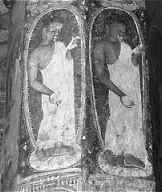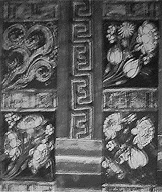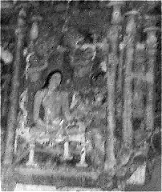|
Buddhism, continued.... After the death of the Buddha, Buddhism spread rapidly in India. Buddhist monks had a duty to travel and sleep in a different place every night, preaching to the people as they went. The only exception was during the rainy season when they would settle in a specific place for 3 to 4 months. The caves at Ajanta were a rain lodge of this type, they are set in a deep and narrow river gorge which is a peaceful and attractive place even now. Some of the caves are living accommodation in which a large central hall is surrounded by individual windowless cells. It seems that the monks may have slept two to a cell since some of them contain two stone beds. Now the only inhabitants are bunches of tiny little bats. It seems that after a while the Buddhist monks in India became decadent and started to build more permanent and more comfortable monasteries. According to our guide this may have contributed to their downfall, they ceased to preach among the people and at the same time Hinduism was enjoying a popular resurgence. The caves in Aurangabad are mainly Buddhist but you can see signs of this transition - in one of the caves Ganesh has taken the place of the Buddha who has been moved off to one side.  
 The caves at Ajanta are completely carved out of the rock of the cliff face, but they are mostly of quite simple architecture and are not impressive for their carvings like the caves at Ellora. After they were hollowed out the cave walls were plastered and painted and it is these murals which everyone goes to see. They are over 2000 years old, but the style of Western art that they have most in common with is early Italian Renaissance. Practically the only way to get an idea of the quality of these paintings without going to the site is to buy one of the more expensive and better-made art books. Visitors are not allowed to photograph the better paintings because of the damage it causes and the paintings of secondary quality do not photograph well. Perhaps this is one of the reasons why even people who know India quite well seem not to have heard of Ajanta. We were lucky when visiting Ajanta in that we had one of the best guides of our whole visit, a man who, despite being lame in one leg, had once trekked through scrub land and stood knee-high in a pile of bat droppings to visit some little-known Buddhist caves! He was genuinely more interested in educating us about the art and culture of India than in selling us things and this is fairly rare for an Indian guide. Some of the more interesting explanations concerned the narratives shown in the paintings. One whole cave is given over to paintings showing the life of the Bhodisattvas. As a young king or prince, with everything that life can offer, the Bhodisattva suddenly decides to seek for a more meaningful, spiritual life. As a trial run, he goes out into the world for a brief period, then returns and announces his intention to become a monk. This inevitably causes distress to his family, especially his wife who seems prepared to go to almost any lengths to tempt him back to a worldly life, including surrounding him with sexy dancing girls. But the Bhodisattva resists, engrossed in his meditation, he no longer notices worldly things and is only one level below the Buddha on the path to enlightenment. Another cave shows scenes from the previous lives of the Buddha. In each of these his willingness to sacrifice himself for others in highlighted, eventually, thanks to his perfection he climbs to the top of the hierarchy of existence and attains Buddha hood. As an elephant the Buddha is responsible for protecting and caring for his two blind parents. But the king of the land is looking for a new elephant and he is captured. Thinking of his parents he refuses all the fine food which is offered to him and is eventually freed to return to them. Other sequences show him as a deer rescuing a man from a pit, a bull allowing a monkey to play about his horns, and a white king of elephants who agrees to sacrifice his tusks to save a queen. |